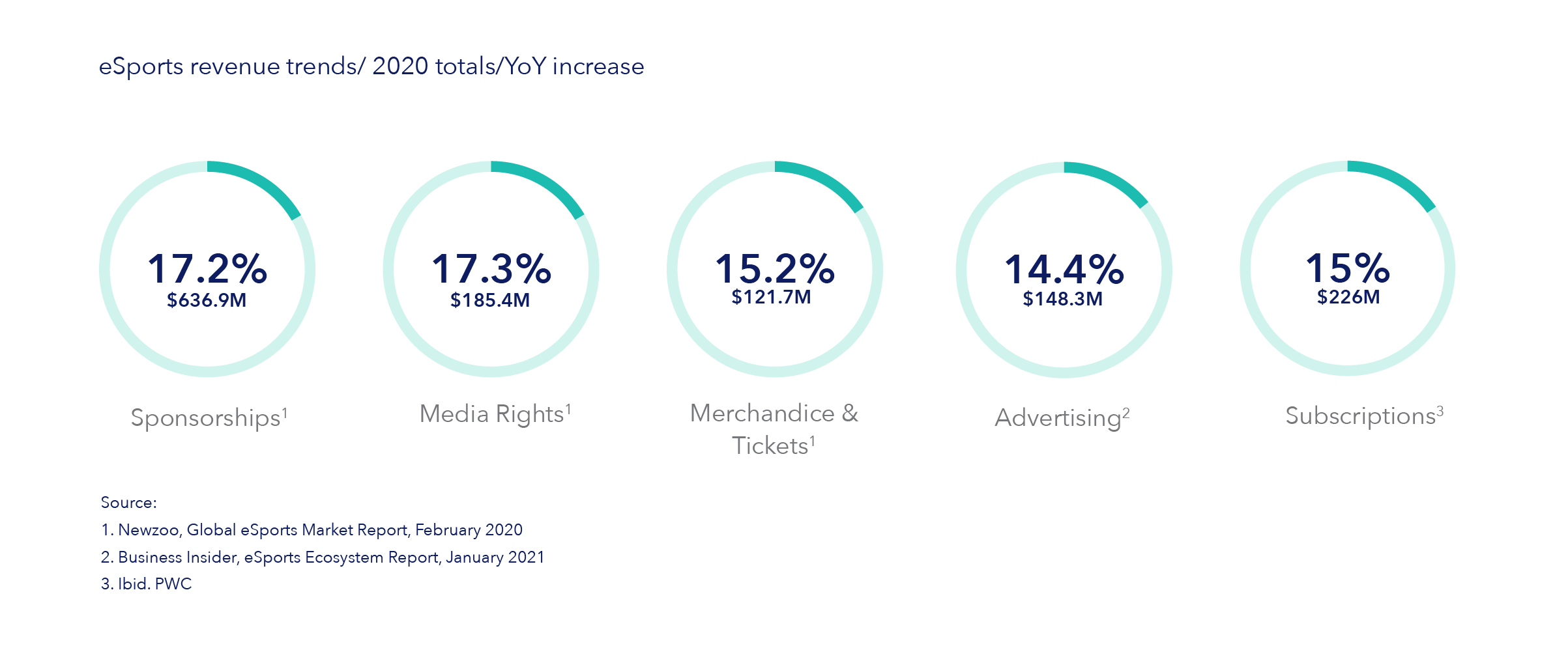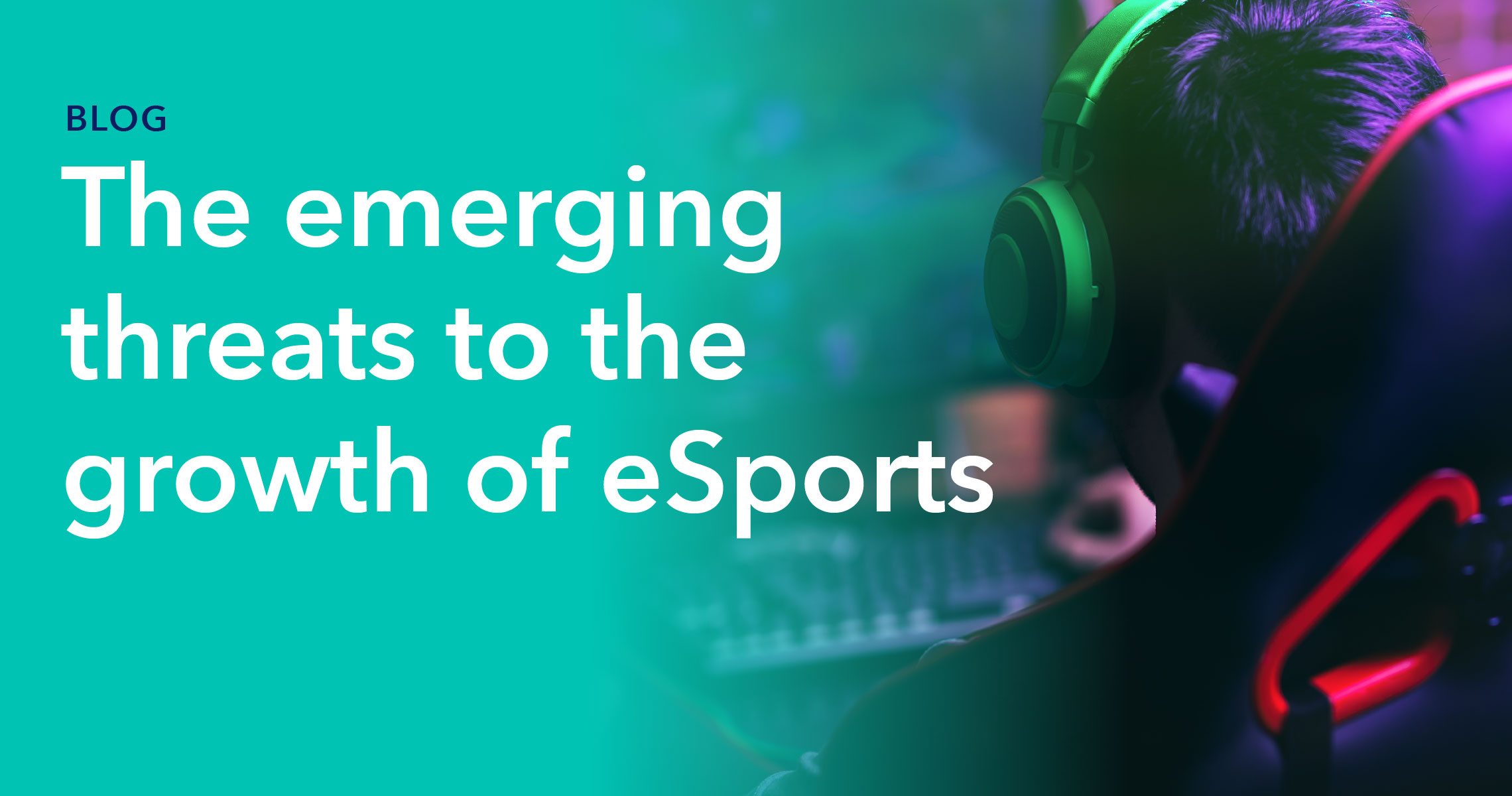eSports is faced with more threats to monetization than ever before. All content producers, from home entertainment to educational material, face attacks on their business models from pirates and hackers. In addition, eSports also faces threats that are completely unique to its ecosystem, such as cheating.
There are two major threat vectors to eSports from illegal online assailants: professional pirates seeking to steal content for their own personal gain, and hackers looking to extract data or perform attacks on gaming communities through apps or websites. These latter attacks are similar to other online entities and are not necessarily unique to gaming or eSports, and include DDoS attacks performed by malicious botnets, SQL injection and code tampering, credential stuffing, and painful ransomware infestations.
As we can see in the figure below, the revenue of eSports is particularly oriented around viewer numbers, with almost half (48.9%) of income being generated by sponsorships, media rights, and advertising. In this environment, not getting the correct figures due to stream pirating represents a major obstacle to the growth and successful monetization of eSports.

Streaming piracy: how it works and its effect on eSports
Streaming piracy can be a very lucrative business, and modern pirates use a number of techniques to profit from the theft of premium content, including:
- Bundling together multiple stolen streams to look like a top-range sports/eSports package that’s offered at a fraction of the cost
- Charging fees for one-off sporting and eSporting events and competitions
- Collecting advertising revenue from their viewers
This might seem harmless to the viewer but in fact, can be quite dangerous. Researchers from the U.S. and Belgium found that more than half of streaming ads on pirate sites contain malware. These ads are able to get around ad-blockers so the ads on pirated streams are even more invasive than those on legitimate sites.
Though pirates have no shame about stealing streams that are already ad-supported elsewhere, for eSports publishers seeking to build their business with a more solid subscription-based model, the threat of piracy looms large over their growth prospects. An interesting aside is the fact that up to 96% of ads on pirate streaming sites are from well-known brands that have shown little desire to help in the fight against content theft.
It is not just advertisers who are complicit in the damage caused by content piracy — consumers play the most important role by fueling the market for stolen streams. A major 10-country survey of sports fans found that over half of them watched pirated content at least once a month. This illegal piracy of sports streams alone is estimated to cost that industry $5.4 billion a year.
The streaming potential of eSports has more in common with live traditional sports than SVOD or other OTT providers as its value lies in its “live” nature and immediacy of the event. However, just like with live sports streaming, this can pose particular challenges as there is limited time to identify and shut down pirate streamers, with speed being essential in the fight.
Content piracy adapts quickly to opportunities
Though the pirating of eSports content is not yet as valuable in absolute terms as live traditional sports, it is very interesting to note how the growth of major user-generated content platforms such as Twitch, YouTube, and Facebook has accelerated the boom in piracy. Amazon’s Twitch, in particular, is a huge favorite among professional and amateur pirates alike. In an article titled “Twitch Has Become a Haven for Live Sports Piracy,” Wired goes in-depth on the threat it poses to legitimate service providers.
The article highlights one of the major advantages pirates have on Twitch: extant communities of gamers, viewers, and eSports fans already feel comfortable enough interacting with each other to, as Wired said, “distribute links to soccer live streams like handfuls of pigeon feed at the park.” This unofficial and free marketing only helps pirates increase their viewership.
How pirates exploit app vulnerabilities
As eSports becomes more successful, and thus larger on the radar of content pirates, it will face the same threats that affect all streaming media services, including pirates who use technical vulnerabilities to hack content and pass it off as their own. These attack vectors include reverse engineering of core functionality, code tampering, and exploiting flaws in apps.
Although reverse engineering has many benefits, including fostering engagement with other developers and enabling easier upgrades, it can also lead to illegal usage or malpractice among the app’s users. Plus, it’s especially prevalent as virtually all software development enables it.
The most popular form of malware that hackers use is to clone real apps in order to steal data from unsuspecting users who think they’re using a legitimate version. A team from North Carolina State University found this was the case for 86% of malware samples they tested. Another mode of infecting devices is to use a malware-as-a-service model, whereby a “dropper” uploads malware to vulnerable smartphones. Malware has also entered the eSports world. One of the most notable examples was when the E-Sports Entertainment Association League database was hacked through a player rating module and the account information of over 1.5 million users was stolen.
Cheating using eSports coding flaws
With eSports and gaming, it’s not just a matter of lost revenue and stolen data — app vulnerabilities can also be exploited to allow players to cheat, thus damaging the integrity of competitions and devaluing the product. A major example of this came from one of the biggest names in the eSports world, Counter-Strike: Global Offensive (CS:GO), where prize money for top competitions can exceed $2 million.
A particular bug was discovered to have been exploited over many years. The industry’s self-policing agency, the eSports Integrity Commission, found that 37 coaches, all of whom are now banned, had been using the bug to gain an edge over competitors. The bug allowed them to see virtually all of the map during gameplay. They passed this information on to their team, which gave them a huge advantage. Though the offending coaches were banned, the incident caused significant reputational damage.
Cheats that exploit code flaws have become a big industry, potentially generating hundreds of millions of dollars around the world. These cheats are used both by professionals in major competitions and amateurs who simply want to boost the appearance of their skills, with the BBC finding that cheating apps are used by around one-third of gamers. The value of these illegal enterprises built around exploiting code vulnerabilities in games was exemplified when the Chinese police broke up a hacking operation in March 2021. The operation had made $76 million from creating cheating software for the global market.
The cheating situation has had a considerable impact on the gaming world, with many becoming discouraged by the ability of hackers and cheaters to distort results. An example of this is Vikkstar, a major gaming streamer for Call of Duty: Warzone with seven million followers. He quit his YouTube channel due to his frustration with cheating. This came right after Activision, the creator of Warzone announced an escalation in cheating apps, some of which contained malware that actually took over users’ cameras or microphones or logged keystrokes to steal valuable information.
The multiple threats facing eSports
The growth of eSports has exposed its business model to a wide range of threats. Content piracy, which seeks to exploit stolen content to rake in ad revenue or even sell subscription streams at lower prices, is an obvious and direct competitor to successful monetization by lawful publishers and distributors. Along with this, software hackers are also seeking to profit from app vulnerabilities and coding flaws to steal data, upload malware, or threaten business disruption. There are even those who wish to profit by selling cheating software that destroys the enjoyability and reputation of games.
With the growth of game streaming platforms, the eSports sector is set to grow incredibly over the next few years, as long as the industry can keep these threats in check. Download the whitepaper to learn more about how the surging success of eSports intensifies the need for robust, affordable security.








